Questions
Task One – Conference Presentation on ethical practice in business
Your manager has asked you to prepare a presentation in readiness for delivery to colleagues on the importance of ethical practice and the business case for such people practices. Your Presentation Pack must include presentation slides, the evidence you have gathered, and presenter notes. It is expected that your presentation pack is aimed at the appropriate audience and is of business format.
You should ensure that your presentation includes a review of the various influences on ethical practice as well as details of a robust business case for the ethical people practices. You also need to provide a Briefing paper as a handout for delegates covering the main points of the presentation in an accessible, easy to read way.
Your presentation should include the following and should refer to the CIPD Profession Map wherever appropriate:
- Define the term professional and explain the requirements of a people professional. (1.1)
- To help explain what is meant by ethical values, give at least three examples of your own personal values and how this affects how you work and develop working relationships. (1.2)
- Drawing upon work or personal examples, analyse how you could/have
- Contributed to discussions to ensure people practices are
- How you can effectively communicate to engage and influence
- How you might raise issues with situations such as organisational policies or the approach to leadership that conflict with legislation or ethical values. (1.3, 5)
- Drawing on relevant theory provides a robust argument that includes both the business and human benefits of people at work feeling included, valued and that they are being treated fairly (2.1)
- Identify a people practice initiative that has been put in place in response to some form of internal or external feedback, set out the purpose of this initiative and explain how you would evaluate the impact of this initiative paying particular attention to levels of engagement within the organisation. (2.2, 3)
Task Two – CPD portfolio
The purpose of this task is to evidence your approach to Continuous professional development as a people practice professional in conjunction with the CIPD Profession Map. The task combines a number of activities which should be presented as a CPD portfolio.
As an introduction to your portfolio it is important to set the scene to your personal learning journey.
Activity 1 – The Context of Professional Development (3.1)
Explain the following;
- How the role of a people professional is changing?
- What impact are these changes having on our CPD?
- What are the key characteristics of a good-practice CPD?
Activity 2 – Self Assessment
The first stage of your CPD should be to understand where you’ve come from, where you are and where you want to be.
- Using the Standards from the CIPD Professional Map, carry out a self-assessment of your competency against the core behaviours identified, a suggested format is provided. this can be in any format, but evidence is required to support this activity took place (an example template is provided in Appendix 1).
- From this Self-assessment, plus other forms of feedback identify your strengths and weaknesses setting personal development objectives to be included within a Professional Development Plan (3.2).
- You now need to consider how you can meet these development objectives, to complete your PDP. Consider the range of learning opportunities available to you and for each development objectives decide on the most appropriate initiative to support your learning journey. (3.3)
Activity 3 – Reflective practice
A key element of our PD is reflecting on our everyday experiences to learn from these, capturing what went well or not so well and how we can learn from such situations.
Your reflections should focus on the following scenarios.
- Identify times when you have taken responsibility for your work/actions, paying particular attention to recognising any mistakes you might have made, how you rectified these mistakes and what you believe you learnt from these experiences. (1.4).
- Identify at least two examples that highlight your approach to working inclusively, plus how you have built positive working relationships with others. Your reflections need to focus on what you did, and the skills and behaviours demonstrated. (2.4)
Activity 4 – assessing the impact of your learning and CPD.
The final part of our CPD is to measure the overall impact of our learning. To achieve this, you need to think about and capture the impacts, covering positive as well as negative. What was the impact on you, your team, your colleagues, your customers, your stakeholders, the organisation or your
department? To support this assessment, you will need to complete a record of your learning for the last 12 months (3.4).
Answers
Conference Presentation on Ethical Practice in Business
Welcome to this presentation on the ethical practices in business. This is an issue that highlights the significant issues, behaviours, norms, and practices that people professionals should relate to in their career goals.
I will start by defining professionalism; this is a term describing people who have gone through training and gained formal education experience. People gain credibility in their profession, which is an attribute that results to individual improved performance in their different professional areas.
The requirements of people professionals are that it enable development of people, people practices, and increases experiences of work among the employees. People professionals and other professionals are guided by the CIPD Professional map, which identifies the core knowledge, core behaviours, and specialist knowledge areas that guide them in their careers and the next strategic actions. These aspects champion for a good work and working environment for the people and within the organisation. People professionals are therefore required to be fully involved in the process of influencing others to build better work experiences for all people.
The requirements of a people professional are;
- They uphold professional ethical standards
- They take a strategic expert approach
- Work with teams and recognizes their contributions to performance and achievement of organisational goals.
After explaining the people professionalism concept, the next section will develop insight on the ethical values among professionals in the business. Ethical values define behaviour among professionals, evaluate the rightfulness or morality of decisions made, determine the norms that guide professionals to right behaviours and culture in their places of work. Ethical values determine the support taken to address dilemmas and different organisational issues. Ethical values are meant to ensure that professionals follow the standards and integrity expected of them in delivery of the right practices in workplace. The ethical values help explain the extent to which action is taken to support all the different people professional functions and ensure that employees are not discriminated, harassment, of treated unfairly. Ethical values guide professionals’ behaviours and engagement in delivery of their practices and different organisational functions.
My personal values and how they are applied in context of professionalism include:
- Value of integrity
- Empowering others
- Responsible leadership
These values are applicable in the context of professionalism where I take responsibility in ensuring that I am honest and truthful in all the actions that I engage in. I demonstrate integrity when working with others, which allows me to develop right ethical behaviours that help me navigate through the ethical dilemmas I experience in my line of work. Empowering others involves engaging others in the decision-making process. This is a value that creates opportunities for people to voice their issues and ideas that affect them and their work. Responsible leadership is an ethical value that determines my capability in influencing others. I am a person who leads by example, encourages others, and holds them accountable for the actions that they engage in. I am a person who accepts responsibility when I make mistakes, and I consider this to be an attribute that promotes my capability to becoming the best role model to others. With these personal values, I have been able to effectively complete my work duties and responsibilities.
I make use of the above mentioned and explained personal values to apply to people practices to ensure that I follow the code of ethics, communicate with others to improve levels of engagement and influence others to promote people capability to work and deliver best results. The application of professional integrity to people practices determines the values, norms, and behaviours that shape an ethical culture. Organisation’s code of ethics guides people’s behaviours and actions. Engaged and motivated workforce is led by people with leadership qualities and effective management of organisational policies that create value for the people and for the organisation.
Having discussed the concepts of professionalism and ethical values, I will focus on explaining the issue of inclusion in organisations. Inclusion means accommodating, respecting, and appreciating all people without looking into their protected characteristics. It is a professional role in ensuring that all people are treated equally and fairly. Inclusion allows professionals to perform to their full potential without discriminating against anyone based on the protected characteristics. The benefits associated to creating an inclusive culture include; creating an environment where
Employee retention is enhanced and building a positive corporate reputation. Inclusion eliminates negative behaviours that experiences that people might face is their places of work. Leaders should take advantage of the diverse groups of people who work together to deliver the different organisational goals and objectives. Leaders in supporting a diverse culture benefit from personnel who by supporting diversity and inclusion become more committed to working in the organisation. People inclusion creates a positive organisational brand that attracts qualified and competent talent and helps organisations gain competitive advantage.
External and internal feedback affects the organisational operations as well as the decisions made by different professionals. Initiatives that people professionals should consider include communicating on the relevant issues. Feedback determines the relations between the employers and employees, and the manner in which employers treat employees determine the professionalism impact in organisations (Shanock et al., 2019). Communication is a process where information is exchanged, and the respondent have to act on it and ensure that they provide the relevant feedback. Communication gives all professionals in an organisation an opportunity to voice their concerns. Through this they get to react to the information that is passed on to them. Good communication platforms improve engagement levels. People professionals respond to external and internal organisational feedback by accepting the trends experienced as a result of the changed nature of work. For example, on the issue of coronavirus, people professionals should be ready to adapt to the new work patterns and people relations to support the organisation and people. The initiative to comply with legal regulations and organisational policies is significant in helping people professionals respond to external and internal feedback. This is important in helping professionals respond to the legal needs of the employees within and out of the organisation.
1.1
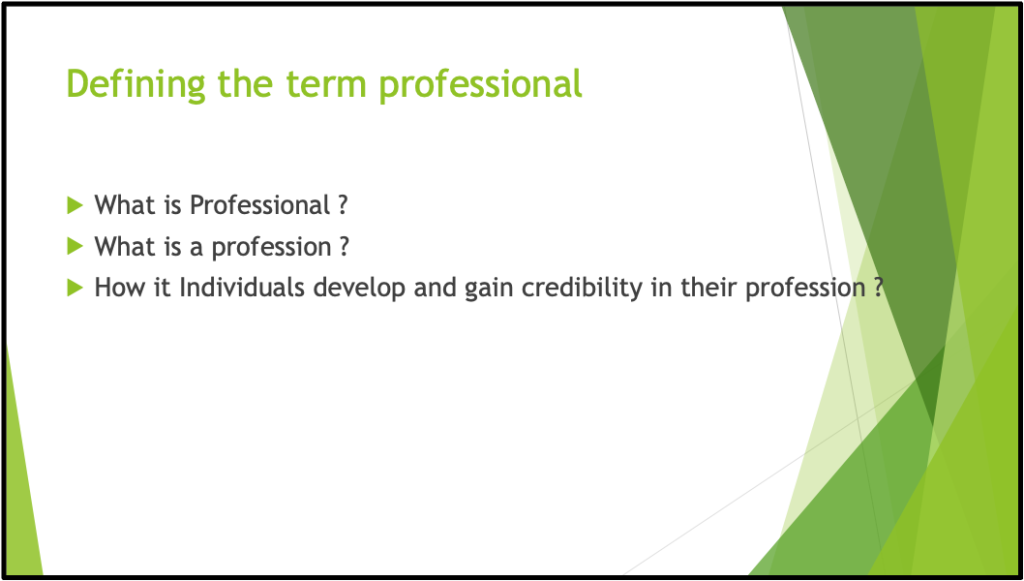
- Professionalism: this is a term describing people who have gone through training and gained formal education experience. People gain credibility in their profession, which is an attribute that results to individual improved performance in their different professional areas. The role of HR is in continuous development cause to social progress, economic and work condition changes. In the last few years, the role of Strategic Partner was born. It is an HR professional that through knowledge, behaviours, and professional skills, can influence the board of director’s decisions and the business direction.
- Professional is a term used to describe people who have gone through training and gained formal education experience. The HR Professional is defined as a Thinking performer, who proposes new ideas based on his knowledge and the principles: added value, improvement, cost reduction, and efficiency. This model was developed from the CIPD in which the levels of effectiveness and efficiency are combined, and a Thinking performer has a high level of both characteristics.
- A profession is a job that an individual works in after going through training, and professionals get a living from the job that they work in.
- Individuals develop and gain credibility in their profession, which is an attribute that results to individual improved performance in their different professional areas.
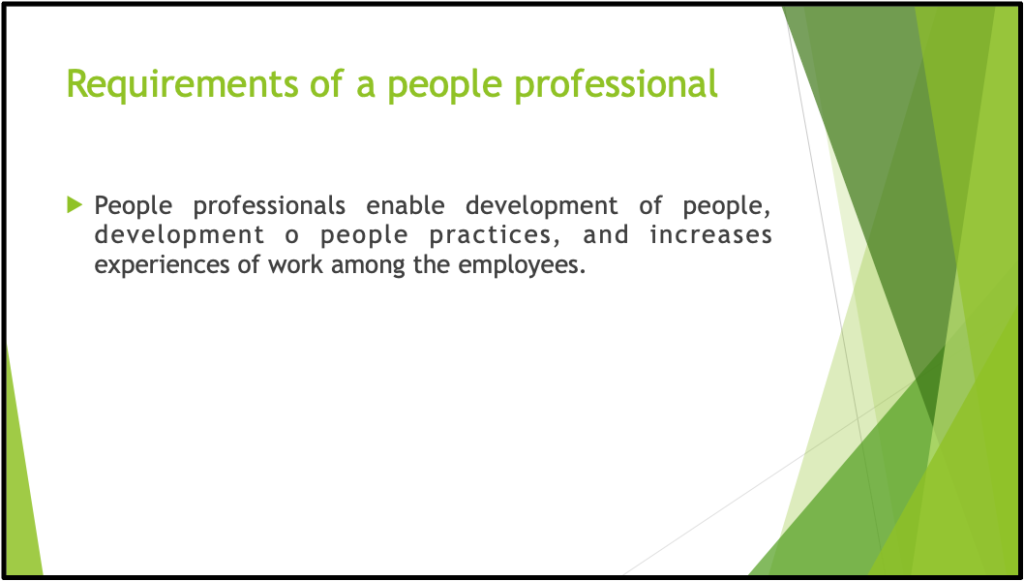
People professionals are guided by core knowledge, core behaviours, and specialist knowledge areas that guide them in their careers and the next strategic actions.
The requirements of a people professional are;
- They uphold professional ethical standards
- They take a strategic expert approach
- Work with teams and recognizes their contributions to performance and achievement of organisational goals.
1.2
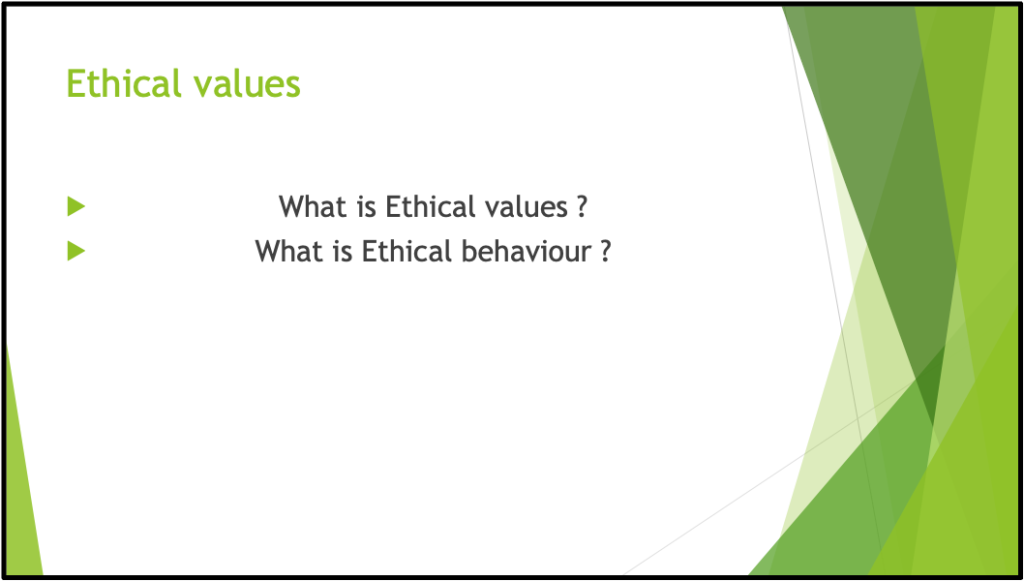
- Ethical values are the conduct, practices and techniques that define behaviour among professionals in the organisation.
- Ethical behaviour is a core concept that determines the rightfulness or morality of decisions made.
- Ethical values influence norms that determine the right behaviours and culture that professionals develop in their places of work.
- Ethical values determine the support taken to address dilemmas and different organisational issues.
An example of my personal values and how they are applied in context of people practice,
- Value of integrity , Empowering others and Responsible leadership
1.3 & 1.5
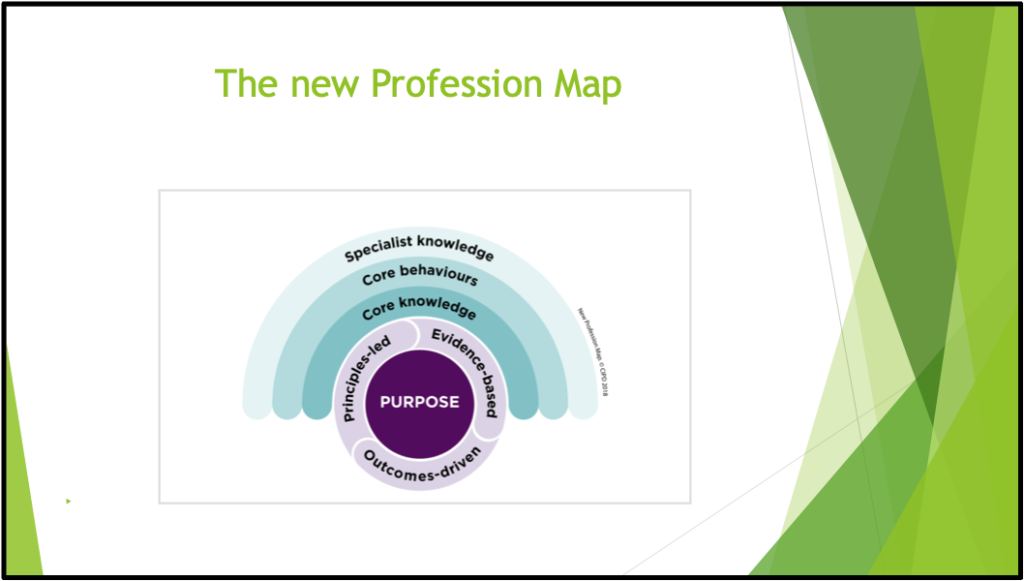
People practices are guided by organisation’s code of ethics, Communicating to engage and influence others is an aspect that determines people capability to work and deliver best results to support organizational success. Discussin the concepts of professionalism and ethical values, and focus on explaining the issue of inclusion in organisations. Inclusion means accommodating, respecting, and appreciating all people without looking into their protected characteristics. It is a professional role in ensuring that all people are treated equally and fairly. Inclusion allows professionals to perform to their full potential without discriminating against anyone based on the protected characteristics. The benefits associated to creating an inclusive culture include; creating an environment where employee retention is enhanced and building a positive corporate reputation. Inclusion eliminates negative behaviours that experiences that people might face is their places of work. Leaders should take advantage of the diverse groups of people who work together to deliver the different organisational goals and objectives. Leaders in supporting a diverse culture benefit from personnel who by supporting diversity and inclusion become more committed to working in the organisation. People inclusion creates a positive organisational brand that attracts qualified and competent talent and helps organisations gain competitive advantage.
2.1
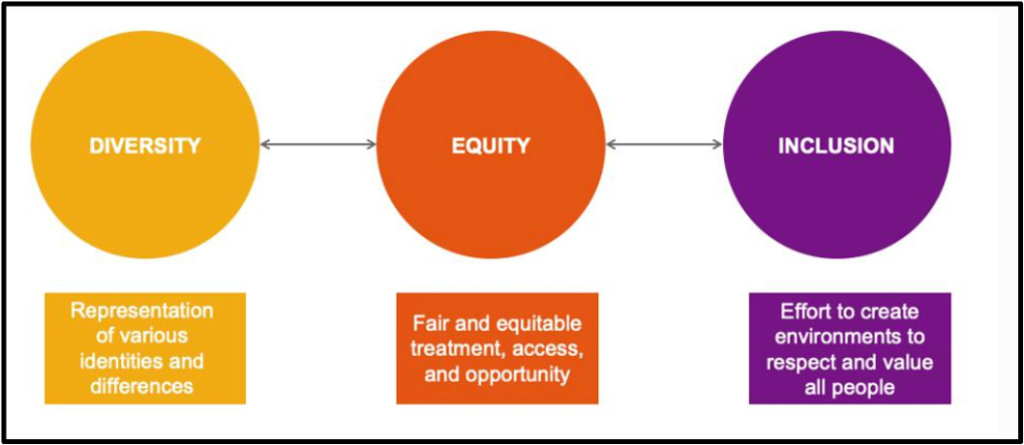
Ensuring employee satisfaction makes them produce more and better, reduces staff turnover, increases team engagement, makes the work environment lighter, and attracts new talent to your company, among others. Moreover, an engaged staff contributes a lot to the evolution of the company’s organizational structure.
Inclusion is the acknowledgement of people’s differences. It is about creating a culture and an environment where all professionals feel they belong. Inclusion allows professionals to perform to their full potential without discriminating against anyone based on the protected characteristics.
Benefits of diversity and inclusion are:
- Enhances retention of talent to support organizational performance
- Builds a positive corporate reputation.
2.2 & 2.3
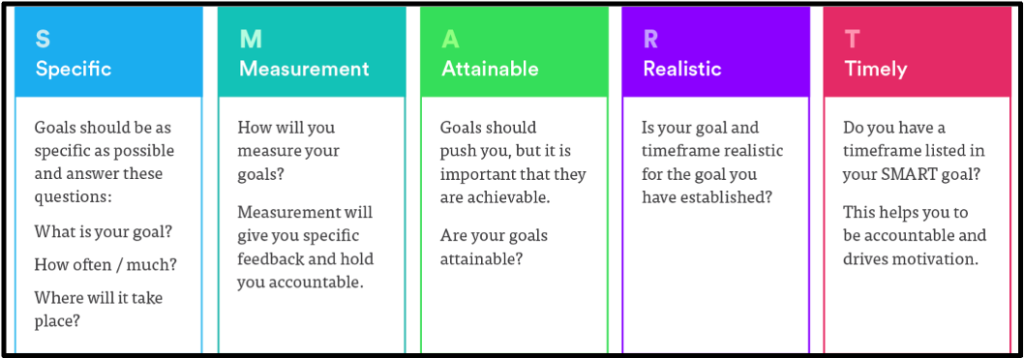
- People professionals should make communication more relevant and keep being focused on people
- Accept new trends from the changing nature of work. Ensure that HR comply with legal regulations and organisational policies.
- Feedback determines the relations between the employers and employees, and the manner in which employers treat employees determine the professionalism impact in organisations (Shanock et al. 2019). The initiative to comply with legal regulations and organisational policies is significant in helping people professionals respond to external and internal feedback. This is important in helping professionals respond to the legal needs of the employees within and out of the organisation.
- People professionals respond to external and internal organisational feedback by accepting the trends experienced as a result of the changed nature of work. For example, on the issue of coronavirus, people professionals should be ready to adapt to the new work patterns and people relations to support the organisation and people. The initiative to comply with legal regulations and organisational policies is significant in helping people professionals respond to external and internal feedback. This is important in helping professionals respond to the legal needs of the employees within and out of the organisation.
3.1
Changing role of people professionals
Changing professional roles of people professionals in the contemporary world have been as a result of the changing nature of work as well as modernisation and the improved roles that this group of professionals is assigned to. The changing technologies also contribute to changing people professional roles. Technological disruptions have affected HR decisions in completing different HR functions. For instance in recruitment and selection process, people professionals have been adopting to a more focused approach to online recruitment. The recruitment process (Green, 2020), has change the manner in which people professionals attract and select talent from the labour market. The contemporary organisation and significance of digital working is an attribute that has contributed to helping people professionals improve the levels of employee engagements, and at the same time promote links between organisational strategies and organisational success. As opposed to the traditional engagement of the people professionals being involved in the process of hiring and firing employees, organisations have considered changes in the 4extent to which the professionals are engaged and involved in decision-making. Different HR models have been introduced to fit in different organisational platforms because no one specific model can fit all organisations. The implementation of models in organisations. People professionals are becoming advisors and strategic partners to other organisational functions to enhance delivery of the organisational objectives.
Impact of changing roles on CPD
Continuous Professional Development (CPD) is a strategic plan that helps professionals become updated with the knowledge and skills that would help them become fully competent in completing current and future professional roles. CPD is linked to learning to allow professionals go through the development process, make the professionals more confident and strengthen their credibility to completing roles that might even seem challenging to them. Through CPD, professionals learn their weaknesses and develop options to effectively manage the weaknesses. It is a plan that helps professionals gain self-improvement.
Characteristics of a good-practice CPD
A good-practice CPD is reflective because it creates an environment for professionals to reflect on their current professional position, and the learning opportunities that would help them progress in their careers.
Individuals should develop their CPD records and plans to identify the actions they have taken to direct their actions and choose the best learning opportunities. The employers should not be involved in developing CPD plans for their employees. The reason behind this is that the employers are responsible in only responsible in supporting the employees through the development process, but they do not make decisions on behalf of the employees.
CPD should have specific development goals set to help find out the learning actions and opportunities that the professional should take to gain more skills and knowledge, and record progress in their careers. The professionals act on these development goals to ensure that they improve and progress on their careers. The goals developed should be specific, measurable, achievable, relevant, and time bound. This means that individuals should be focused enough to make the right decisions and deliver the right objectives relevant to creating progress in their careers.
CPD should provide opportunities for formal and informal learning. Professionals should engage in all forms of learning, which are platforms to gaining more skills. The employers should provide opportunities for professionals to get access to the different learning opportunities. Leaning is important because it enhances development of more skills and knowledge, which are needed in completing the assigned duties. Organisations that uphold a learning culture relate well with the employees because they feel that the opportunities given to them to learn make them become more responsible. They feel valued and contribute significantly to organisational progress.
3.3
PDP
| What do I want/need to learn? | What will I do to achieve this? | What resources or support will I need? | What will my success criteria be? | Target dates for review and completion |
|---|---|---|---|---|
| Improve on my Communication skills | I will hold meetings regularly to discuss job issues. | I need support by employees to attend the meetings and engage in discussions. | I will ensure the right people attend the meetings, take the minimal time possible and ensure every participant feels a sense of belonging. | June 2021 |
| Create a culture where employees engagement is supported | I will hold state of engagement group discussions that is engaging to everyone | Blog posts with the latest information on employees engagement. | Recognition and encouragement to employees to motivate them. | June 2021 |
| Create a culture of Learning and development | Hold physical trainings for people to engage in discussions and share new ideas and eLearning to learn new things from different sources online. | Support from the management, CIPD learning materials, Internet and published materials from different sources. | To develop a learning culture at work for personal skills improvement and also acquire more information on how to improve on development in an organisation. | June 2021 |
| Ensure that I work with professionals who understand and value Cultural diversity | I will organize exchange programs for everyone to share their values and beliefs. | Support from management team and CIPD learning materials. | Engagement and empowering of employees to make them realize their values and beliefs are recognized and valued regardless of their differences. | July 2021 |
| Identify methods of managing conflict | I will identify the current conflicts, know the course and different ways of resolving them. | I will need CIPD reference on how to resolve conflicts and also refer from the previous conflicts to learn how those kinds of conflicts were resolved. | To identify the different ways of resolving conflicts, the importance of conflicts management at work and ensuring all employees are happy and satisfied with the way conflicts are being resolved. | July 2021 |
3.2
Strength:
- My personal administration in the company and basic skills are good and my detailed knowledge is generally sound for my level of training
- I gained confidence from previous experience weather in life or work and that’s reflect to my work, Able to identify and define problems, analyse problems to find causes.
- Having the ability and the opportunity to lead a big team and manage them and be under pressure with them
Weakness:
- It is difficult for me to make a balance between personal life and work life,
- I have issue for asking someone for help, as I feel myself independent it’s difficult for me to ask for help when I need it.
- Wants tasks completed quickly, May be too critical of other’s contributions and work and focus so much in the details.
Development objectives to Complete PDP
- I will have my support from my manager to achieve and get over my weakness.
- Prove to my manager that I have had both structured management and leadership and experience of leading teams to achieve specific tasks.
- Set aside time to complete your evaluation and find your original plan, complete with goals and activities.
1.4
One of the areas where I would want to improve on is on the communication skills. I find this to be a weakness especially because I work with professionals who are from different backgrounds. Failure to acquire good communication skills night lead to disagreements. On the same, I intend to work with employees and create a culture where diversity and inclusion are valued. To achieve this, developing exchange programs where people can share about their backgrounds would be an opportunity to achieve my objective to valuing diversity.
2.4
Interacting and working with different people with different beliefs and different patterns of work, I intend to identify and adapt to the different methods of resolving conflicts. Finally, I intend to identify platforms to create high levels of employee engagement and create learning opportunities for all employees to gain knowledge that will help me progress in my career.
| 3.4 Key dates | What did you do? | Why? | What did you learn from this? | How have/will you use this? |
|---|---|---|---|---|
| 4th - 9th April | I engaged the employees in an inter-departmental exchange program. | I wanted to understand how communication between employees in different department is perceived. | I learned that Interdepartmental communication helps in building trust, tolerance and self-awareness increasing new skills development and accurate information delivery which is essential in growth and development of an organization. | I will use this in organizing weekly interdepartmental exchange programs and meetings to make them interact. |
| 12th - 16th April | I organized an escape in the room challenge for the employee. | My purpose for this was to motivate the employees, promote teamwork, help them to develop their strength and address their weakness. | Through team building activities, employees learn a lot about each other, they address their fears and weaknesses, share their strengths and capabilities which strengthens their relationship and trust. | I will encourage more team building activities that brings about the sense of cooperation and collaboration to help improve teamwork. |
| 19th - 23rd April | I organized an activity pairing employees with different backgrounds and asked them to share challenges that they feel the other background may be facing. | The aim was to make employee share the different types of diverse backgrounds to identify different challenges and their solutions. | I learned that the activity brings out an empathetic team and builds a positive attitude toward the minority. | This cultivated ideas of more such activities to build of inclusion, the sense of integration among the employees regardless of their differences, and their ideas are valued. |
| 26th - 30th April | I invited a mentor for a five-day career growth session with the employees. | My aim was to encourage learning to improve knowledge and skills. | Through learning employees develop new ideas improving competence and career growth. | I intend to hold such sessions regularly to enhance professionalism and career and personal growth. |
| 3rd - 7th May | I engage the employees in planning a workplace tournament. | The aim of this was to facilitate networking, sharing of different ideas and suggestions to ensure employees feel satisfied and have a sense of belonging. | I learned that employees feel happier when engaged, they even offer to volunteer in making an event a success, they develop trust, increasing productivity and efficiency. | Ensure that everyone is fully engaged in making decision of issues that involves them to increase commitment, passionate efforts at work and satisfaction. |
| 10th - 14th May | Held an open discussion with employees to share their values, essential holidays and events. | I wanted to acquire cultural knowledge amongst employees, understand their personal values and beliefs. | I learned that different groups are willing to embrace different culture and diverse beliefs that different groups of employees have. | I will use this to bring together different groups and encourage them to appreciate the diversity. |
References:
Cambridge Dictionary – Definition of Professionalism [online] [Accessed on 22 May 2021], available at. https://dictionary.cambridge.org/dictionary/english/
CIPD Professional Map, 2018. [online] [Accessed on 22 May 2021], available at. https://peopleprofession.cipd.org/profession-map
CIPD Championing better work and working lives, 2020. Code of Professional Conduct – Ref: 7460 [online][Accessed on 23 May 2021], available at. https://www.cipd.co.uk/about/what-we-do/professional- standards/code
Gifford, J. and Young, J., 2021. Employee engagement and motivation, available from https://www.cipd.co.uk/knowledge/fundamental/relations/engagement/factsheet#gref [Accessed 22nd May 2021]
Green, M., 2020. Recruitment process overview, available from https://www.cipd.co.uk/knowledge/fundamentals/people/recruitment/factsheet#gref [Accessed 22nd May 2021]
Green, M. and Russell, T., 2021. Ethical practice and the role of people professionals, available from https://www.cipd.co.uk/knowledge/culture/ethics/role-hr-factsheet#gref [Accessed 22nd May 2021]
Shanock, L.R., Eisenberger, R., Heggestad, E.D., Malone, G., Clark, L., Dunn, A. M., … and Woznyj, H., 2019. Treating employees well: The value of organizational support theory in human resource management. The Psychologist-Manager Journal, 22(3-4), 168.
Wahab A. and Green, M., 2021. Inclusion and diversity in the workplace, available from https://www.cipd.co.uk/knowledge/fundamentals/relations/diversity/factsheet#gref [Accessed



